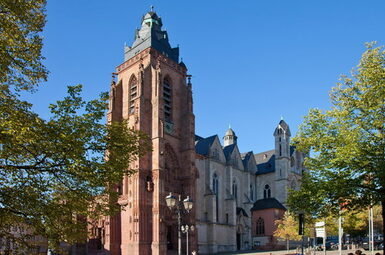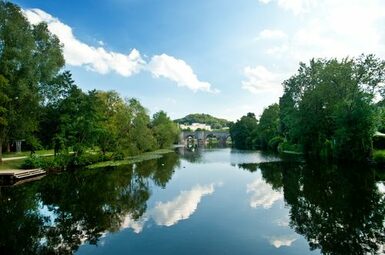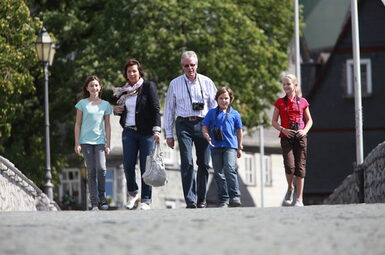Wetzlar in...
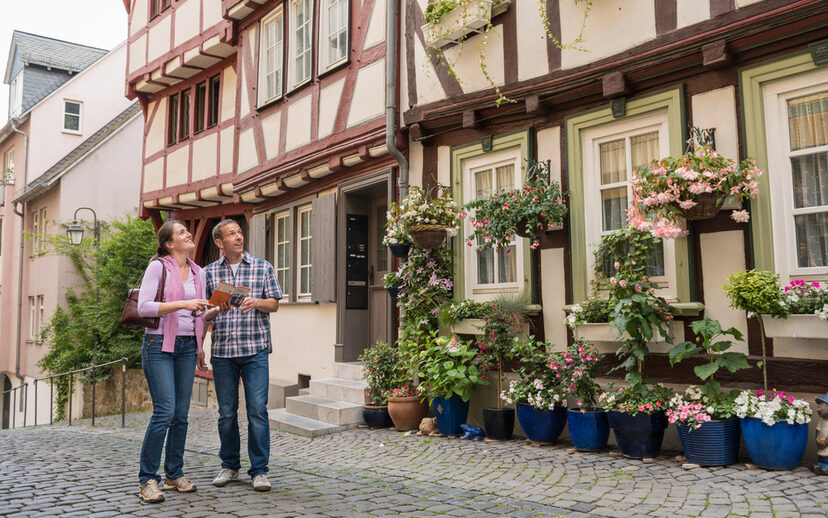
...two hours
Wetzlar is easy to reach by rail, and the old part of the town is only 20 minutes’ walk from the railway station. Otherwise you can take the citybus, which runs from the bus station near the Train station to the historical centre from Mondays to Fridays, 10 a.m. to 7 p.m. Wetzlar is also an excellent centre for cyclists and walkers. If you are driving to Wetzlar, make use of the convenient multi-storey car park near the cathedral. Follow the signs to the Parkhaus am Dom.
To the right of the cathedral you will see the Hauptwache, Wetzlar’s guard-house from the Prussian era. From here, walk up the Pfaffengasse (lit. “Priests’ Alley”) to reach the Deutschordenshof, the former courtyard of the Teutonic Order. The main buildings here house the Town and Industry Museums.
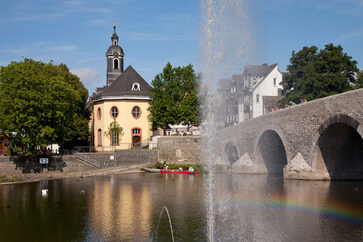
The Lotte House is in the former Administrator’s House. It is a memorial to the summer of 1772 when Goethe met Charlotte Buff and came to the house almost every day. On display are paintings and etchings, letters, furniture and household objects.
Two rooms upstairs in the museum are devoted to a permanent exhibition of "The Sorrows of Young Werther", Goethe’s first novel which was to make him world-famous. The display documents how the story came into existence and its influence on literature and society.
Return now to the Dom, the cathedral, which was originally a collegiate church. It is Wetzlar’s distinctive landmark and emblem. The mixed periods of its architecture reflect the history of the town and you will find a masterful combination of the Romanesque and Gothic styles in the building.
An unusual aspect of the Dom is that it has served both Protestant and Catholic parishes since the Reformation and that although called a cathedral, it has never had a bishop.
...four hours
Standing at the west gate of the cathedral (the Dom), you cannot fail to be struck by the beautiful conformity of the row of houses across the square. Number 8 is the old town hall of 1790, which now houses Tourist Information. To the south-west, the Domplatz (“Cathedral Square”) leads onto the Fischmarkt, the former fish market. Number 13 is also an erstwhile town hall, but it was turned over to the Imperial Chamber Court in 1693 to be used for sessions. The two-headed black imperial eagle on the front wall testifies to this. Further south, Domplatz 17 used to be the inn called Zum Kronprinzen (“The Crown Prince”) where young Goethe spent many an hour in joyous company at the “round table”.
Go through the narrow Schmiedgasse (lit. “Smiths Alley”) to the Kornmarkt (“Corn Market”) with the imperial-city fountain. Notable buildings here are the former inn called Zum Reichsapfel (“The Imperial Ball”) and on the southern side, house No. 7, which was Goethes abode during his months in Wetzlar.
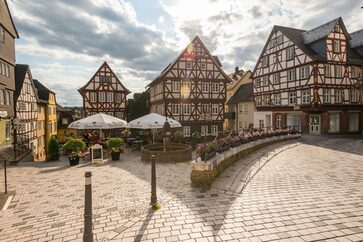
The passage at the Römischer Kaiser (“The Roman Emperor”), house No. 5, will take you to the Säuturm, the “sows tower”. This is the only remaining tower belonging to the mediaeval town fortification. The Avignon Park begins here and is part of the green belt round the historic town, providing lovely views of the Lahn valley and of the old ruins on the thickly wooded mount called the Kalsmunt.
Walk down through the park and take the second exit to the right into the Rosengasse (“Rose Alley”) and then into the Kornblumengasse (“Cornflower Alley”). The corner house on the left (Kornblumengasse 1) houses European furniture and works of art collected by Dr. Irmgard von Lemmers-Danforth from the Renaissance and Baroque periods. Opposite, at Hofstatt 19, you will find the museum of the Imperial Chamber Court, which is devoted to the history of the supreme court of the Holy Roman Empire of the German Nation.
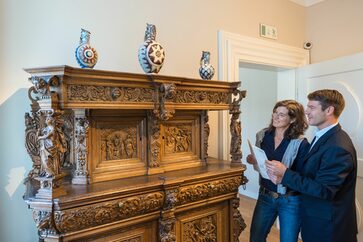
Go down the Kornblumengasse to reach the square called the Schillerplatz. The Jerusalem House (No. 5) in the charming row of half-timbered buildings is particularly striking with its two gables. This house is a memorial to Karl Wilhelm Jerusalem, who was a figure of considerable importance in literary history with regard to Goethes novel, "The Sorrows of Young Werther". The Gothic church building belonging to the former Franciscan friary dates back to around 1300.
We recommend you take the street called the Silhöferstraße to the Eisenmarkt (the “Iron Market”). This former market place, the smallest in Wetzlar, boasts two wonderful examples of half-timbered architecture; one is the Alte Münz (“The Old Mint”) at No. 9, and the other is the old Löwen-Apotheke (“The Lion Pharmacy”) at No. 7. Follow the Krämerstraße (“Chandler Street”) and the Schwarzadlergasse (“Black Eagle Alley”) to return to the cathedral and the Domplatz.
...a day
You have already explored much of the old part of the town (“two hours” or “four hours in Wetzlar”). Here are some ideas for excursions beyond the former city walls.
Retrace Goethe’s steps
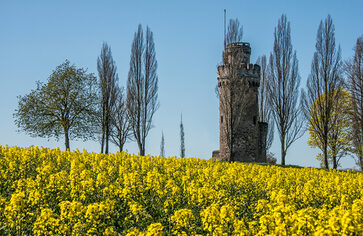
Start at the Lottehaus (“The Lotte House”) and proceed to the old city gate called the Wöllbacher Tor in order to reach the Rosengärtchen (“The Rose-Garden”) with the memorial to Karl Wilhelm Jerusalem. Now descend to the well called the Goethebrunnen. The steep uphill road called the Wahlheimer Weg will take you on a walk to the next village, Garbenheim, which figures as Goethe’s Wahlheim in Werther. On the way be sure to stop at the old watchtower, the Garbenheimer Warte, otherwise known as the Bismarckturm, a tower providing a wonderful view of the Lahn valley.
To get a bird’s eye view...
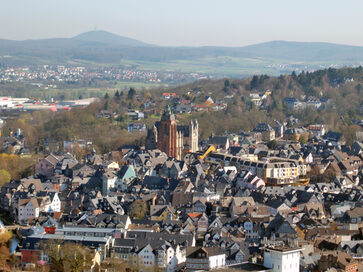
...of the town and its surroundings, take the steep path up to the Kalsmunt. The ruined tower is the oldest part of the castle built by Friedrich Barbarossa around 1180 to protect his imperial city. The panoramic view from its platform is unique and stretches from the Feldberg, the highest point of the Taunus, to the heights of the Westerwald and to the hills of the Hinterland.
Return to the old town, if you still have some time left, and visit the Town and Industry Museum. Here you will find excellent displays illustrating the history of Wetzlar and its industrial life. There are also collections of paintings and a gallery with temporary exhibitions.
If these excursions have left you with an appetite, try one of the many eating places in Wetzlar. You can choose between local specialities, international cuisine and gourmet menus. Pleasant cafés and good hotels are also at your service.
...two days
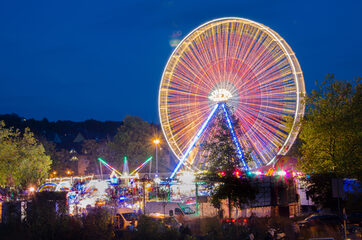
The former imperial city has more to offer in the way of culture beyond its museums. There is a wide choice of concerts, plays and art exhibitions. Wetzlar is well-known for its Festspiele in July and August, the festival-in-the-park of performing arts on the open-air stage in the Rosengärtchen. And Wetzlar knows how to celebrate. Every three years the largest agricultural show in the Lahn-Dill area, the Ochsenfest, attracts large crowds with all the fun of the fair. Every year there are festivities in the Carnival season, and town festivals from the summer to October, when the traditional Gallusmarkt takes place.
If you are interested in sport, Wetzlar has the Europa indoor swimming pool and the Domblick outdoor pool with a view of the cathedral. A stadium is near the centre of town and there are also facilities for almost every kind of sport you can think of. Discover the Lahn valley on our cycle paths and on the river. Even if you are a beginner, you will be able to hire the right boat for you.
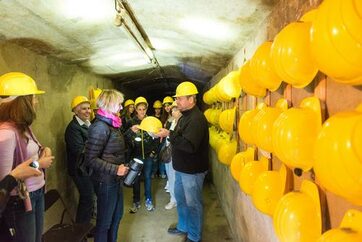
There is plenty to discover outside Wetzlar. On top of the hill in Solms-Oberbiel, see the last iron-ore mine in Hessen, the Grube Fortuna, which has been preserved in its working state. You will be taken 150 metres down the machine shaft and then transported by train to the iron-ore pits. Try out the mining experience as the original tools and machines are demonstrated to you.
On an eleven-kilometre trip west of Wetzlar to Braunfels, it will not be long before you catch a glimpse of the “fairy-tale castle”. You cannot fail to be charmed by this little town in the Taunus. Be sure to visit the castle and be transported into the past.
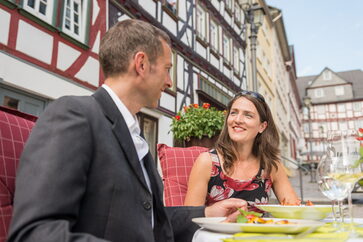
Back in Wetzlar, visit the Naturschutz-Zentrum Hessen, the nature conservation centre, with its educational nature trail. From here it is not far up to the Kirschenwäldchen, (“The Cherry Woods”), a popular recreational area in Wetzlar which belongs to the nature reserves of the High Taunus. Here you will find restaurants and cafés and paths through the woods, including an educational trail up to the Stoppelberg, the highest point in Wetzlar.
End the day by strolling along the banks of the Lahn. Spend the evening in the friendly inns and restaurants of Wetzlar, where you are sure to unwind and meet the local people. You will have spent two days getting acquainted with the Wetzlar way of life. A charming town which you will always be glad to come back to.

